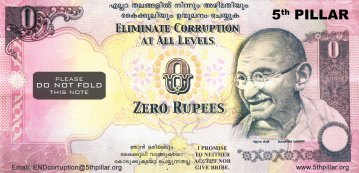
What does a zero rupee note have in common with a gigantic Brazilian broom?
Both represent strong citizen movements against corruption in large “middle income countries” which are vibrant democracies. Both countries have important laws (like India’s Right to Information Act and anti-bribery laws) and legal frameworks (like Brazil’s 1988 Constitution), but face challenges in guaranteeing that these serve the poorest.
And Brazil and India between them have over a third of the world’s billion poorest people according to recent data. Andy Sumner of IDS recently challenged the idea that the majority of the poor live “less developed countries” where per capita income is lowest, showing that almost three quarters of those living with less than $1.25 a day actually live in “middle income countries.”
In this context, fighting poverty is about fighting persistent inequalities in some of the world’s fastest growing economies. As Sumner says, “poverty is increasingly turning from an international to a national distribution problem.”
Theft of public monies and political patronage is a major obstacle to achieving poverty reduction and inequality in both countries. In Brazil this election year, for example, there have been reports of candidates extending health services, metal roofing and cash grants to only to poor communities that vote for them. These are the same candidates that turn a blind eye to the poor when they are in power.
But in India and Brazil, as the zero rupee note and the Brazilian broom demonstrate, citizen movements are pushing for reform and full implementation of existing laws.
Sumner’s report calls on international development actors to contemplate what these large populations of poor in emerging economies mean for our work. So what is the role of international actors in these processes of fighting political patronage, theft of public monies, and persistent inequalities? Starting here at home, clamping down on European and North American private sector collusion in the theft of public monies through bribery and money laundering is one area where my colleagues are working hard.
Another crucial role for agencies like ours, is to continue to support “incubators” for such expressions of the popular will for reform in countries like Brazil, where almost 10 million people live on under $1.25 a day.
CAFOD has supported the Brazilian Justice and Peace Commission for decades, during which it participated in a broad campaign to pass a law preventing vote buying. This campaign mobilized millions of Brazilians and was the first of its kind in 1998. Years passed, and the broad movement behind the campaign began hatching another – to bar criminals (those convicted of looting public coffers, even murdering opponents and trafficking drugs) from ballots in Brazil.
This second campaign called “Ficha Limpa” (or “Clean Record”) took years of soul-searching, coordination, planning, articulation with other important actors like the Brazilian Bar Association. CAFOD’s long-term partnership and solidarity with the Brazilian Justice and Peace Commission provided the much-needed incubator for this.
Now we are seeing the results – the passage of a law which has already barred over 200 criminals from ballots during this election year, and will hopefully be upheld by the Supreme Court.
The campaign has repeatedly achieved tens of thousands of signatures and emails to all branches of Brazilian government, and it has given Brazilians a new language for, and a new hope in, reform. It is crucial to remember, that before it became a political and legal “fact”, the Ficha Limpa was a social fact.
We are planning research into the Ficha Limpa campaign to better understand the factors for its success, and in future to monitor its impacts in reducing political patronage, and eventually poverty reduction.
August 30, 2011 at 5:22 pm |
[…] year ago, I wrote a post called “The ‘middle income’ poor and corruption” about campaigns in India and Brazil against corruption. Lessons we learned from campaigns in […]